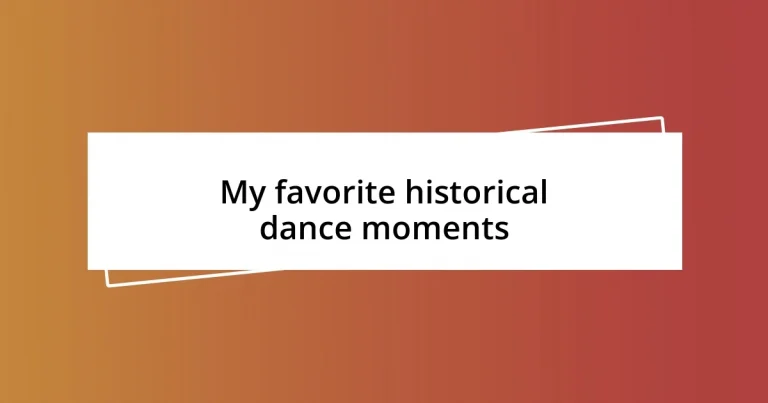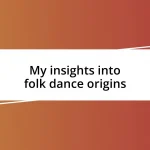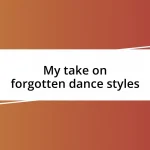Key takeaways:
- Historical dance moments reflect cultural evolution, societal values, and emotional states, connecting past generations to the present.
- Notable dance forms like the Tarantella, Ballets Russes, and The Twist illustrate how dance can serve as both a healing art and a catalyst for social change.
- Dance serves as a universal language that fosters community, inspires artistic expression, and enables cultural exchange in today’s global society.
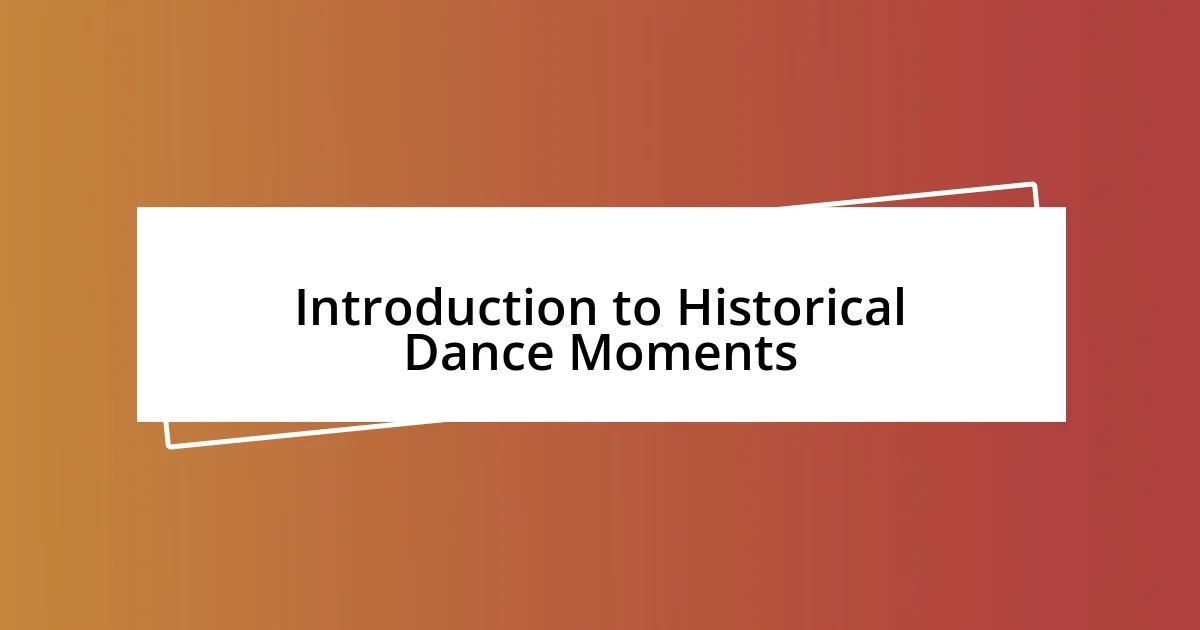
Introduction to Historical Dance Moments
Historical dance moments are more than just rhythmic movements; they are powerful reflections of culture, emotion, and societal values through time. For me, every step taken in these dances tells a story that connects generations, allowing us to glimpse into the past. Isn’t it fascinating how a simple pirouette or a lively jig can evoke so much history?
I remember watching a documentary on the court dances of the Renaissance, where the grace and precision of each movement captivated me. It struck me as a beautiful testament to the formality and ritual of that era. How often do we consider the significance of those dances beyond mere entertainment? They shaped social interactions and represented the status of individuals within their communities.
Dance moments also serve as a bridge to understanding the emotions of different eras. For instance, the exuberance of the Charleston in the 1920s mirrors the joy and relief that followed World War I. It makes me wonder what stories the dances of today will tell future generations about our times. Each historical dance captures a moment in time, bringing us closer to the people who lived it.
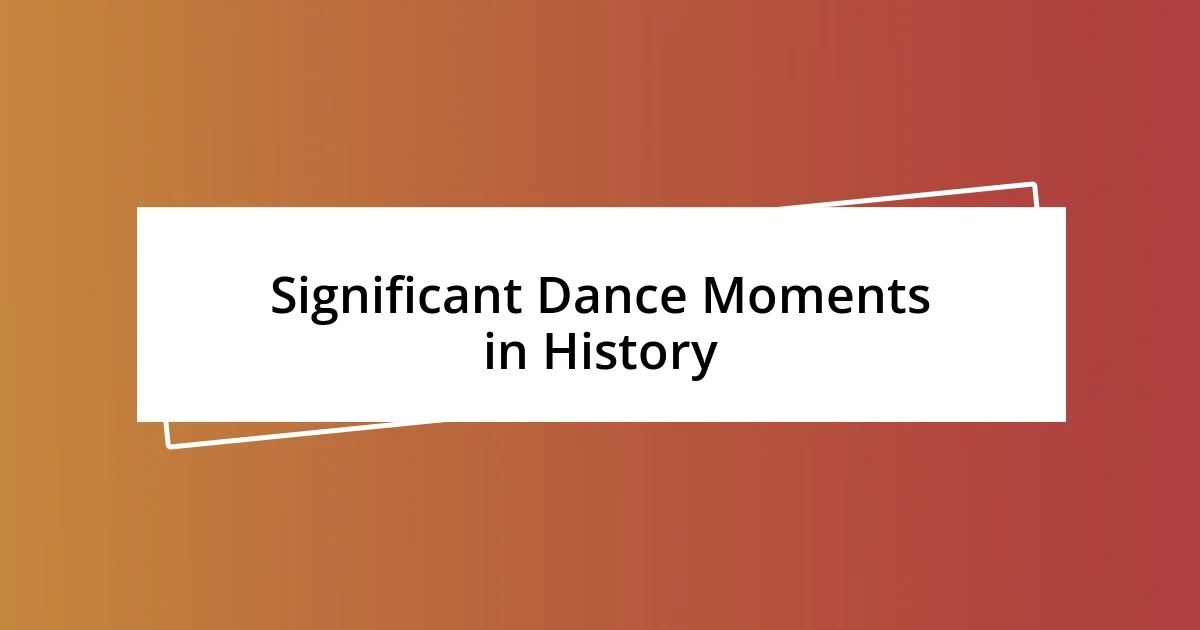
Significant Dance Moments in History
The impact of significant dance moments in history resonates deeply with me. Take the famous dance of the Tarantella, for instance; it originated in the 15th century and was believed to cure the bite of a tarantula. Isn’t it intriguing how a cultural phenomenon can spring from such a dramatic myth? When I learned about this dance, I was struck by how movement not only became a form of expression but also a method of healing, revealing the intertwined nature of art and life in historical contexts.
Another pivotal moment is the introduction of the Ballets Russes in the early 20th century. The company revolutionized the world of ballet by integrating innovative choreography and modern music. I can still remember the awe I felt while watching a performance of “The Firebird”—the vivid colors, the emotive storytelling through dance—it brought an entirely new dimension to the art. It made me realize how revolutionary these dancers were, transforming ballet from a court art form into a dynamic vehicle for contemporary expression.
Significant dance moments also highlight societal change. The Civil Rights Movement saw dances like the Twist bring people together, transcending racial divide through the power of rhythm. I recall the first time I attempted the Twist at a family gathering; the laughter and joy in the room were palpable. This moment made me appreciate how dance can serve as a unifying force, connecting people across backgrounds and experiences, demonstrating the profound impact of dance on social progress.
| Dance Moment | Historical Context |
|---|---|
| Tarantella | 15th century, believed as a cure for tarantula bites |
| Ballets Russes | Early 20th century, revolutionized ballet with modern elements |
| The Twist | Civil Rights Movement era, unifying dance across racial divisions |
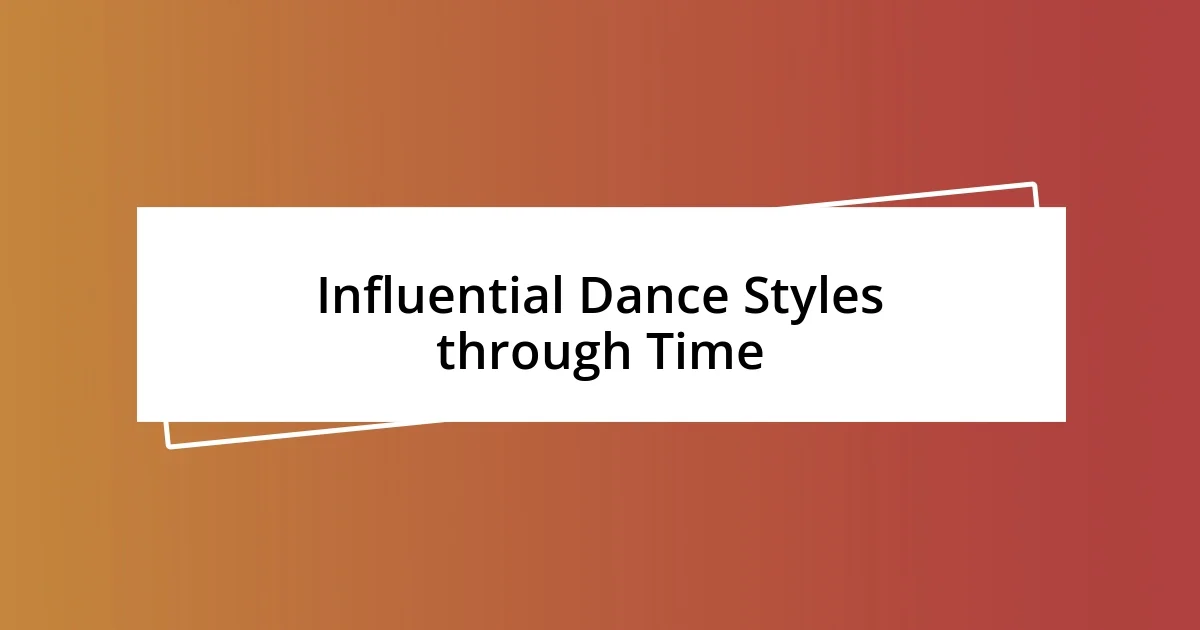
Influential Dance Styles through Time
Throughout history, various dance styles have emerged, reflecting the cultural shifts and societal values of their time. One that stands out for me is the flamenco, which originated in the Spanish Gypsy communities in the 18th century. Its passionate movements and emotions are a vivid expression of struggle and resilience. I once attended a flamenco performance, and the intensity of the dancers left me breathless. The way they conveyed both joy and sorrow through their movements was captivating—it felt as if they were sharing their stories with the audience.
Another notable style is the Lindy Hop, born in the vibrant dances halls of Harlem in the 1930s. It represents a spirited response to the jazz era, filled with improvisation and energy. I recall trying the Lindy Hop for the first time; I felt exhilarated as I twirled and spun, losing myself in the rhythm. The dance brought a sense of liberation, showcasing how dance can transform not just moments, but entire cultural landscapes.
Influential Dance Styles
- Flamenco: Evolved in the 18th century, combining emotion and storytelling.
- Lindy Hop: Emerged in the 1930s Harlem jazz scene, emphasizing improvisation and energy.
- Ballet: Originating in the Renaissance courts, ballet symbolizes hierarchy and grace, later evolving into a platform for storytelling.
- Hip Hop: Developed in the late 20th century as a voice for youth culture and social issues, continually influencing music and dance today.
- Samba: Rooted in Afro-Brazilian culture, samba reflects joy and community, becoming central to Carnival celebrations.
These styles not only represent their unique eras but also showcase how dance can serve as an expressive outlet for society’s emotions and aspirations.
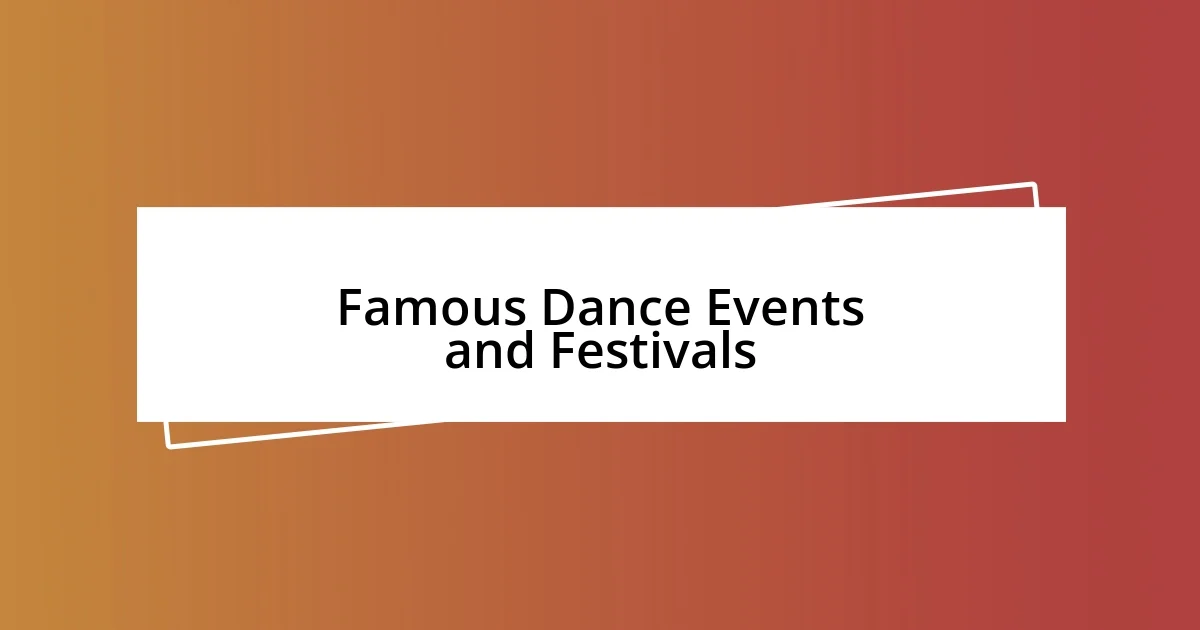
Famous Dance Events and Festivals
The world of dance festivals opens up a treasure trove of creativity and cultural celebration. I’ll never forget the spirit of the International Dance Festival in Seoul, where hundreds of dancers from various styles come together. The atmosphere was electric, with the rhythm of traditional Taekwondo performances merging seamlessly with contemporary dance. This vibrant mix illustrates how dance festivals can truly be a melting pot of traditions, don’t you think?
One festival that particularly resonates with me is the Edinburgh Festival Fringe. It showcases an incredible array of dance—from classical ballet to experimental pieces. Attending this festival felt like diving into a treasure chest of artistic expression. I watched a group perform an avant-garde piece that left me pondering its meaning long after the final bow. It was an excellent reminder of why I cherish these events; they challenge my perspective and inspire me to think critically about artistry in new ways.
And then there’s the iconic Carnival in Rio de Janeiro. The vivid costumes and infectious samba rhythms create an atmosphere that’s unlike any other celebration I’ve experienced. When I danced amidst the lively parades, I felt an overwhelming sense of joy and belonging. It’s amazing how dance can transform a city into a joyous spectacle and connect people through shared experiences. Festivals like these not only celebrate dance but also foster community bonds that can last a lifetime.
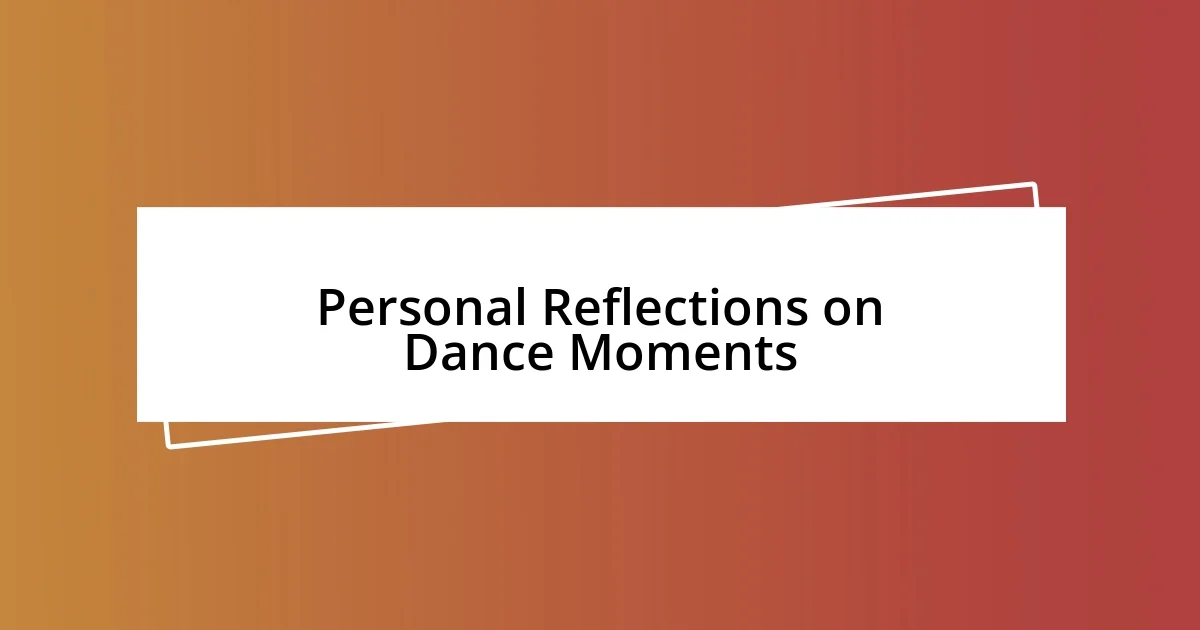
Personal Reflections on Dance Moments
When I think about my favorite dance moments, one that truly stands out is participating in a community flash mob. The sheer excitement of synchronizing movements with a diverse group of strangers was unlike anything I had experienced before. As we danced to an infectious pop song in the city square, I felt a wave of joy wash over me, reminding me of the powerful connections dance can create, even among those who had just met.
I also remember attending a small dance workshop led by a renowned contemporary dancer—what a transformative experience that was! The way they guided us to express our emotions through movement was eye-opening. I left feeling empowered and more in touch with my body than ever. It made me wonder: how crucial is it for all of us to explore our own forms of expression? Sometimes, stepping outside of our comfort zones can unlock previously hidden passions.
There’s something magical about watching my niece dance at her school’s annual recital. Her face lights up with sheer happiness as she performs. In those moments, I am reminded of the simplicity and purity of dance as a form of self-expression. Each twirl she makes and every smile she shares resonates deeply with me. Isn’t it fascinating how the innocence of childlike joy in dance can remind us of the power and beauty of movement in its truest form?
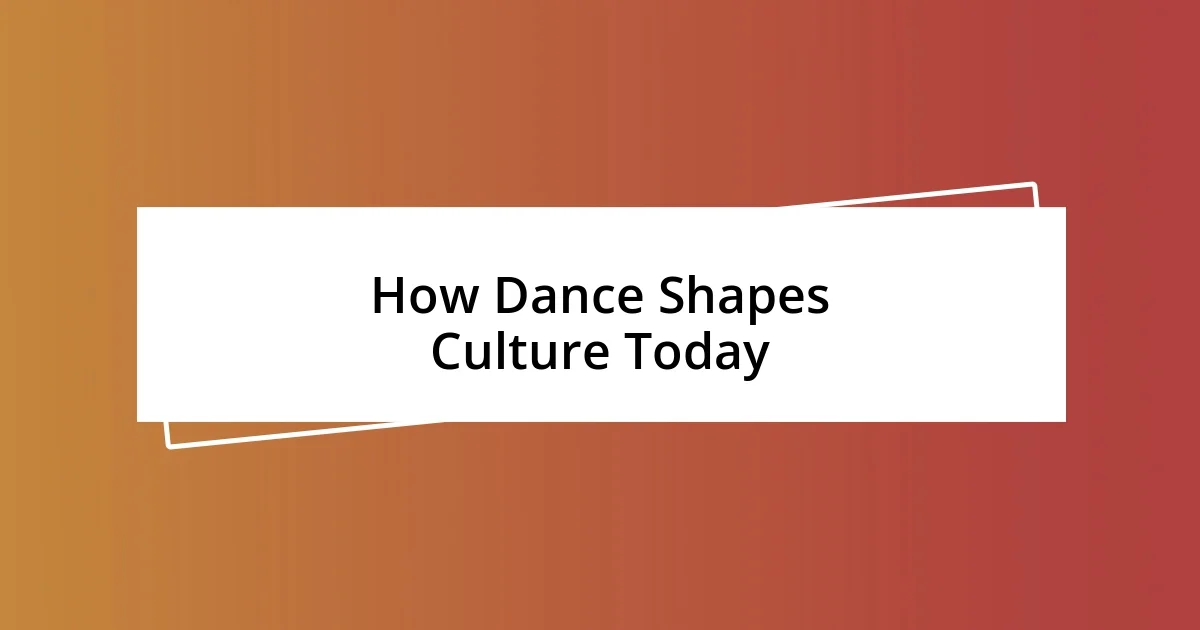
How Dance Shapes Culture Today
Dance is such a profound cultural force today; it not only reflects societal values but actively shapes them. I often find myself moved when watching dance styles evolve to incorporate modern social issues. For instance, I came across a hip-hop routine that creatively addressed climate change. Witnessing how the artists used their platform to express urgency around this topic reminded me that dance can be a powerful vehicle for advocacy and awareness.
In my experience, the intermingling of dance styles across cultures fosters a rich tapestry of shared understanding. I remember attending a cultural exchange program where ballet dancers collaborated with traditional Indian Kathak performers. The fusion was breathtaking! It was as if each dancer was sharing a piece of their soul, breaking borders and creating harmony. This collaborative spirit speaks volumes about how dance can bridge gaps and promote dialogue in our increasingly globalized society.
Every time I step into a dance class filled with diverse participants, I feel the palpable energy of different backgrounds coming together. I can’t help but think: how many stories are swirling around in that room? Each person’s unique history and cultural background adds depth to the experience. This mix not only enriches our understanding of each other but also reminds us that, at its core, dance is a universal language that transcends barriers and forges connections that can last a lifetime.












